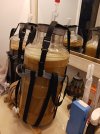- Joined
- Mar 31, 2021
- Messages
- 4,261
- Reaction score
- 6,333
- Points
- 113
Both, you will eliminate fluctuations by the control. A simple old fridge with an inkbird can do it.You guys are great! Thank you for the continued advice and support.
I was expecting a lot of folks might suggest lagering but I am blown away by the number of responses that offered "temperature control" as being a big factor in their ales. I ferment in a very temperature stable (66F-68F) finished basement, in a glass carboy, using primarily US-05. All of my pale ales have fermented along the same predictable schedule, with similar results with respect to flavor, gravity etc. When you refer to temperature control are you talking about eliminating fluctuations or fermenting at a specific temperature to get a better end result. What kind of improvements could I expect? Is US-05 just particularly forgiving or well suited for 66F-68F? Or am I making lousy beer and just havent figured that out yet?!?!?!? (Joking)
I am eager to begin kegging, it has been on my short list of additions for a while. Until I can find a used set up locally I am ok with bottling.
TrialBen had a great suggestion about the Quarterly Brew. My brew-ducation thus far has targeted specific elements in my process. Its probably a good time to bring it all together to see how close I can get to a specific end product.
Thanks again everyone.
GDubs
But yes you are not stuck with whatever temp your basement is that day.










